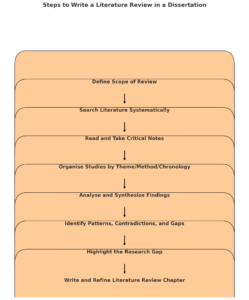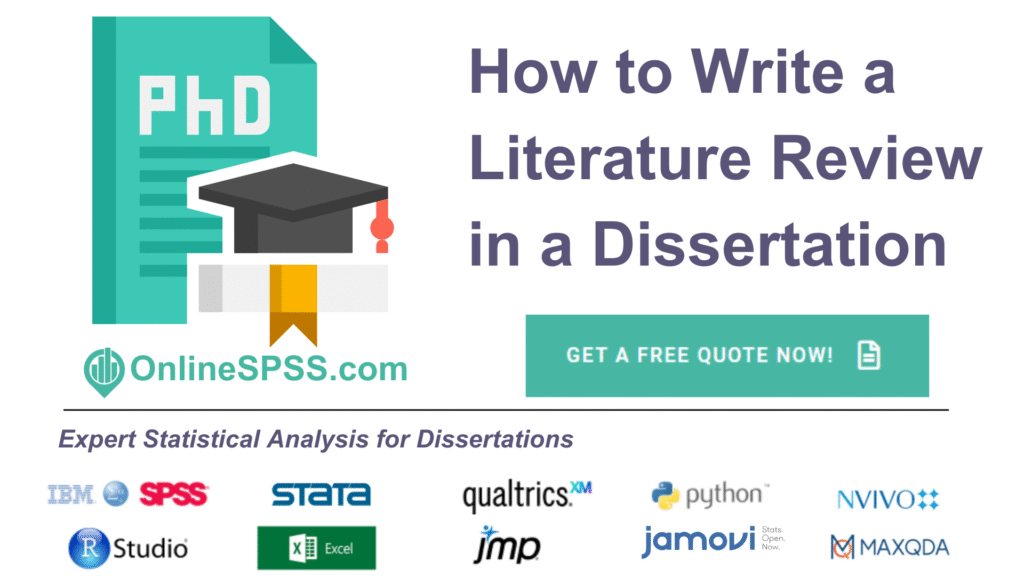How to Write a Literature Review in a Dissertation: A Comprehensive Guide for Students
The literature review chapter is often one of the most challenging sections of a dissertation. Unlike the introduction, which sets the stage, the literature review critically examines what has already been written about your topic and shows how your study will add something new. It is not a simple summary of books and articles. Instead, it is an analytical and evaluative chapter where you demonstrate your ability to engage with scholarship, identify gaps, and build a conceptual foundation for your own research.
A well-written literature review proves to examiners that you understand the field, that your study is rooted in existing knowledge, and that you can think critically about how different studies connect to each other. When approached correctly, this chapter strengthens the credibility of your entire dissertation.
Discover our complete dissertation guide series: [Abstract], [Introduction], [Literature Review], [Methodology], [Results], [Conclusion], [Discussion], [References], and [Appendix].
What is the Purpose of a Literature Review in a Dissertation?
The literature review has several essential purposes. It demonstrates that you know the academic context of your topic. In addition, it helps you identify what has already been studied and where gaps remain. Moreover, it provides a theoretical and conceptual framework that guides your analysis. Most importantly, it shows examiners that your research is not being conducted in isolation but builds upon and contributes to ongoing debates.
In short, the literature review should answer three questions:
- What is already known about this topic?
- What is missing, contradictory, or underexplored?
- How does your research fit within and extend this knowledge?
How Long Should the Literature Review Be?
The length of the literature review varies depending on the dissertation requirements, but it often accounts for 20 to 25 percent of the total word count. For a 15,000-word dissertation, this would typically be 3,000 to 4,000 words. At PhD level, it is often a full chapter of 8,000 words or more. The key is to balance depth with focus. The review should be comprehensive but not overloaded with irrelevant details.
Step-by-Step Guide to Writing a Literature Review
Step 1. Define Your Scope
Before you start reading, you must decide on the boundaries of your review. Ask yourself:
- What specific topic or problem am I focusing on?
- Which time period or geographical area is most relevant?
- Do I need to include both academic and grey literature (e.g., reports, policy papers)?
Clearly defining your scope prevents your review from becoming unfocused or too broad.
Step 2. Search Systematically
A high-quality literature review requires a structured search strategy. Use academic databases such as Scopus, Web of Science, or PubMed depending on your field. Keep a record of:
- Keywords and search terms
- Databases consulted
- Inclusion and exclusion criteria
This makes your review transparent and replicable, which examiners value highly.

Step 3. Read Critically, Not Passively
Reading for a literature review is very different from reading for general understanding. You are not just collecting summaries. You are analysing and comparing. When reading, ask:
- What methods were used in this study?
- What are the key findings and limitations?
- How does this connect to other research?
- Does it support or challenge my assumptions?
Take structured notes that capture both content and critique.
Step 4. Organise the Literature
One of the biggest difficulties students face is organising hundreds of sources into a coherent narrative. The best reviews are not written source by source but structured around themes, debates, or conceptual frameworks. Possible ways to organise include:
- Thematic: grouping studies by topic or theme
- Chronological: tracing how ideas developed over time
- Methodological: comparing different research methods used
- Theoretical: examining key concepts and frameworks
Choose the structure that best supports your research problem.
Step 5. Analyse and Synthesise
The literature review must go beyond description. Synthesis means bringing studies together to identify patterns, contradictions, and gaps. For example, instead of writing, “Author A found X, Author B found Y,” ask yourself what these findings mean collectively. Do they suggest a consistent trend, or do they reveal disagreements? Synthesis demonstrates critical thinking and adds depth to your writing.
Step 6. Identify the Gap
At the end of the review, you must point clearly to the gap your dissertation will address. This could be a methodological limitation, a population that has been neglected, a theoretical inconsistency, or a new context that has not been studied. This gap provides the rationale for your study and connects the literature review directly to your research objectives.
What Should Be Included in the Literature Review?
A strong literature review typically contains:
- An overview of the field to introduce the reader to key concepts
- Critical analysis of existing studies, highlighting strengths and weaknesses
- A synthesis of findings across different sources
- Discussion of theoretical frameworks relevant to your study
- A clear identification of gaps or areas for further research
Writing Style for the Literature Review
The literature review should be written in a formal, academic style but remain accessible. Avoid long lists of studies without commentary. Instead, integrate sources into your own narrative. Use transition phrases such as “in contrast,” “similarly,” and “building upon” to guide the reader. Always write in a way that demonstrates analysis rather than description.
Common Mistakes in Literature Reviews
Students often fall into predictable pitfalls:
- Summarising each study in isolation without synthesis
- Failing to identify clear themes or patterns
- Including irrelevant or outdated sources
- Neglecting to highlight gaps in the literature
- Writing a literature review that is too descriptive and not critical
Avoiding these mistakes will make your literature review much stronger and more persuasive.









